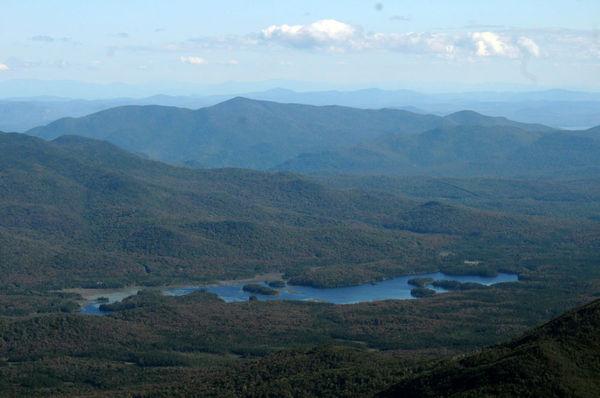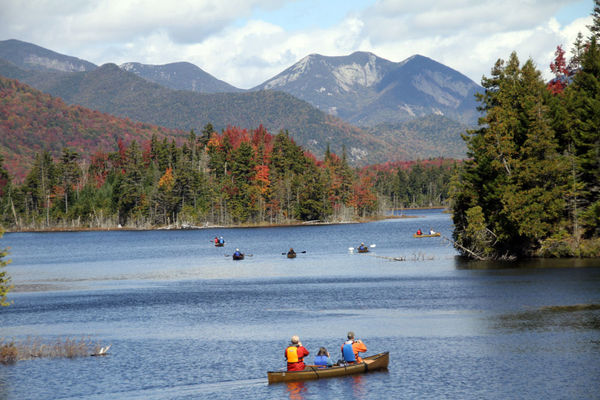APA approves Boreas Ponds classification

Boreas Ponds is seen from an airplane in September 2008. (News photo — Mike Lynch)
RAY BROOK – The state Adirondack Park Agency board voted to approve a classification for the Boreas Ponds tract Friday that will add more than 11,000 acres to the High Peaks Wilderness Area, while keeping more than 9,000 acres as mechanized-recreation-friendly wild forest.
After more than a year of study and public hearings, the APA board voted 8-1 to approve, with the lone dissenting vote coming from board member Chad Dawson.
Dawson said repeatedly through this week’s two days of meetings and in the past that he was unhappy with the process of classifying lands, and he made multiple requests to agency staff for more information.
“If there are conversations that go back to the governor and local towns many, many years [ago], I wish there were some way to get them on the record so we could all understand, so it could be part of the final decision-making process,” Dawson said after the vote. “If there were promises made, if there were some kind of agreements that were reached, then we would like to know where it is and what it means.
“Because it does factor into decisions of land acquisition, and it therefore should have some place in classification. To me, it should all be part of the public record.”

New York state government officials and news reporters paddle on Boreas Ponds in September 2012. In the background is the Great Range — from left, Basin, Saddleback, Gothics and Pyramid — in the High Peaks Wilderness. (News photo — Mike Lynch)
Towns within the Adirondack Park have veto power over state land acquisitions, and local town supervisors may be able to extract promises from the state over how land will be classified in order to approve the purchase. Dawson said not knowing what those promises are may hinder his ability as an APA board member.
On Thursday this week, Dawson had questions on a larger package of classifications the APA was voting on. This package included 99 parcels of land, most of which were simply correcting small map errors. But he said discussion by the APA board should be expanded when a large classification package comes up.
“I’d like to see a little more information,” he said. “I trust the [APA] staff, and I know the staff is doing well in their job, but I need to have a little information to feel comfortable when I vote. A lot more on the public record, that’s all I’m asking.”
The Boreas plan, known as Alternative 2B, was the recommended plan put forth by APA staff. It would essentially take the northern half of the property and add it to the High Peaks, while the southern portion would be added to the Vanderwhacker Wild Forest.
The classification of Boreas was one of the most followed decisions in APA history, drawing more than 11,000 written comments and about 24 hours of verbal public comments at a series of public meetings last year.
While some groups railed against the plan for not including more wilderness, local governments and the larger Adirondack green groups applauded what they see as a compromise that adds to wilderness while still leaving open the possibility of snowmobile and mountain bike trails, along with access for people with disabilities.
The APA approved the classification, but the state Department of Environmental Conservation will have to develop a unit management plan (UMP) that details how and where the public will be provided recreational opportunities.
The Boreas parcel is currently overseen by an interim recreation plan, and it is unclear when the DEC will issue a new UMP. It is also possible the DEC could, instead of redoing the entire High Peaks UMP, issue an amendment to that UMP to address the new lands.
DEC Region 5 Director Bob Stegemann said he is unsure when the department would issue a new UMP, but he said the DEC would likely have at least an interim plan for this coming summer.
“We need to go through the process to do it [draft a UMP], but it’s top of the pile,” he said. “We’re going to make that a real top priority, [and] get it out ASAP with the idea that people can use it this year.”
He said the interim UMP is “going to get adjusted because that plan was based on not having anything classified yet. Now that it’s classified, maybe we can adjust it.”
Boreas and several other parcels will be added to the High Peaks Wilderness Area, but Stegemann said he didn’t know if the DEC would develop a whole new UMP or manage the new parcels under amendments.
“The premier thing is to have one unit and have it be one concise unit,” he said. “The whole purpose of it is to have a management unit that’s tied together on a landscape basis.”
The APA board also unanimously approved 99 other parcel classifications. Most were minor or small parcels, while others – such as MacIntyre East and West and Casey Brook – are more substantial. The approvals will eventually create the largest wilderness area in the Northeast, and third largest east of the Rockies.
- New York state government officials and news reporters paddle on Boreas Ponds in September 2012. In the background is the Great Range — from left, Basin, Saddleback, Gothics and Pyramid — in the High Peaks Wilderness. (News photo — Mike Lynch)



